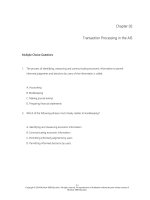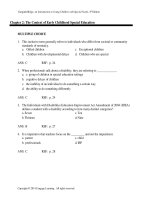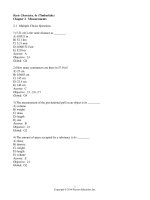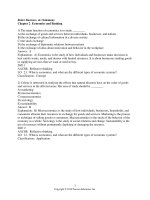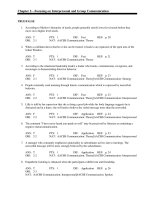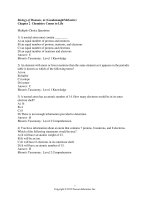Organic chemistry 4th edition smith test bank
Bạn đang xem bản rút gọn của tài liệu. Xem và tải ngay bản đầy đủ của tài liệu tại đây (219.76 KB, 9 trang )
Chapter 2: Acids and Bases
1. Which of the following statements is a correct definition for a Brønsted-Lowry acid?
A) Proton acceptor
C) Electron pair acceptor
B) Electron pair donor
D) Proton donor
2. Which of the following statements about a Brønsted-Lowry base is true?
A) The net charge may be zero, positive, or negative.
B) All Brønsted-Lowry bases contain a lone pair of electrons or a bond.
C) All Brønsted-Lowry bases contain a proton.
D) The net charge may be zero or positive.
3. Which of the following compounds is both a Brønsted-Lowry acid and base?
A) I, II B) I, III C) II, IV
D) I, IV
4. Which of the following species cannot act as both a Brønsted-Lowry acid and base?
A) HCO3- B) HSO4- C) HO- D) H2PO45. Which of the following species is not a Brønsted-Lowry base?
A) BF3 B) NH3 C) H2O D) PO436. Which of the following statements about Brønsted-Lowry acids and bases is true?
A) Loss of a proton from a base forms its conjugate acid.
B) Loss of a proton from an acid forms its conjugate base.
C) Gain of a proton by an acid forms its conjugate base.
D) Brønsted-Lowry acid-base reactions always result in the transfer of a proton from a
base to an acid.
7. Which of the following species is the conjugate base of methanol, CH3OH?
A) CH3OH2+ B) CH3O- C) CH3- D) CH4
8. Which of the following species is the conjugate base of the hydronium ion, H3O+?
A) H3O B) H2O- C) H2O D) HO9. Which of the following species is the conjugate acid of ammonia, NH3?
A) H4N B) H3N+ C) H2N- D) H4N+
Page 1
Chapter 2: Acids and Bases
10. Which is the conjugate acid in the following reaction?
A) I B) II C) III D) IV
11. Which is the conjugate base in the following reaction?
A) I B) II C) III D) IV
12. Which is the conjugate acid in the following reaction?
A) I B) II C) III D) IV
13. Which is the conjugate base in the following reaction?
A) I B) II C) III D) IV
14. Which of the following statements about acid strength is true?
A) The stronger the acid, the further the equilibrium lies to the left.
B) The stronger the acid, the smaller the Ka.
C) The stronger the acid, the larger the pKa.
D) The stronger the acid, the smaller the pKa.
15. Which of the following compounds is the strongest acid?
A) I B) II C) III D) IV
16. Which of the following compounds is the strongest acid?
A) CH3OH B) BrCH2OH C) CH3NH2 D) CH3Cl
Page 2
Chapter 2: Acids and Bases
17. Which of the following compounds is the weakest acid?
A) HF B) HCl C) HBr D) HI
18. Which of the following compounds is the weakest acid?
A) H2S B) PH3 C) HCl D) SiH4
19. Which of the following species is the strongest base?
A) HO- B) H2N- C) CH3COO- D) Cl20. Which of the following ranks the compounds in order of increasing basicity, putting the
least basic first?
A) CH3NH2 < CH3OH < CH4
C) CH4 < CH3NH2 < CH3OH
B) CH3OH < CH3NH2 < CH4
D) CH4 < CH3OH < CH3NH2
21. Consider the following molecule with protons labeled, I-III. Rank these protons in
order of decreasing acidity, putting the most acidic first.
A) I > II > III B) I > III > II C) III > II > I D) III > I > II
22. Rank the following compounds in order of increasing acidity, putting the least acidic
first.
A) III < I < IV < II
B) III < IV < I < II
C) II < I < IV < III
D) III < I < II < IV
23. Rank the following compounds in order of increasing acidity, putting the least acidic
first.
A) I < IV < III < II
B) I < III < IV < II
C) II < III < IV < I
D) II < IV < III < I
Page 3
Chapter 2: Acids and Bases
24. Rank the following compounds in order of decreasing acidity, putting the most acidic
first.
A) IV > II > III > I
B) III > II > IV > I
C) I > II > IV > III
D) III > IV > II > I
25. Rank the following compounds in order of decreasing acidity, putting the most acidic
first.
A) IV > II > III > I
B) IV > III > II > I
C) III > IV > II > I
D) III > IV > I > II
26. Rank the following conjugate bases in order of increasing basicity, putting the least
basic first.
A) II < I < III B) II < III < I C) I < II < III D) I < III < II
27. Rank the following conjugate bases in order of decreasing basicity, putting the most
basic first.
A) II > I > III B) I > II > III C) III > I > II D) III > II > I
28. Which of the following is the strongest base?
A) CH3COCH3 B) CH3COOH C) NH3 D) H2O
Page 4
Chapter 2: Acids and Bases
29. What is the direction of equilibrium when acetylene (C2H2) reacts with H2N- in an acidbase reaction?
A) Left
B) Right
C) Neither
D) Cannot be determined
30. What is the direction of equilibrium when acetylene (C2H2) reacts with ethoxide
(CH3CH2O-) in an acid-base reaction?
A) Left
B) Right
C) Neither
D) Cannot be determined
31. Which of the following statements explain why H2O is a stronger acid than CH4?
A) H2O can form hydrogen bonds while CH4 cannot.
B) H2O forms a less stable conjugate base, HO-.
C) CH4 forms a more stable conjugate base, CH3-.
D) H2O forms a more stable conjugate base, HO-.
32. Which of the following statements explain why HBr is a stronger acid than HF?
A) Br- is more stable than F- because Br- is larger than F-.
B) Br- is less stable than F- because Br- is larger than F-.
C) Br- is more stable than F- because Br- is less electronegative than F-.
D) Br- is less stable than F- because Br- is less electronegative than F-.
33. Which of the following compounds has the lowest pKa?
A) H2O B) H2S C) NH3 D) CH4
34. Which of the following concepts can be used to explain the difference in acidity
between acetic acid (CH3COOH) and ethanol (CH3CH2OH)?
A) Hybridization B) Electronegativity C) Resonance D) Size
35. Which of the following concepts can be used to explain the difference in acidity
between acetylene (C2H2) and ethylene (C2H4)?
A) Size B) Resonance C) Inductive effect D) Hybridization
36. Which of the following concepts can be used to explain the difference in acidity
between ethanol (CH3CH2OH) and 2-fluoroethanol (FCH2CH2OH)?
A) Size B) Inductive effect C) Resonance D) Hybridization
Page 5
Chapter 2: Acids and Bases
37. Rank the following compounds in order of decreasing acidity, putting the most acidic
first.
A) I > II > III B) III > II > I C) II > III > I D) III > I > II
38. Which of the following statements about Lewis acids is true?
A) Lewis acids are proton donors.
B) Lewis acids are proton acceptors.
C) Lewis acids are electron pair donors.
D) Lewis acids are electron pair acceptors.
39. Which of the following statements about Lewis bases is true?
A) Lewis bases are electron pair acceptors.
B) Lewis bases are electron pair donors.
C) Lewis bases are proton donors.
D) Lewis bases are proton acceptors.
40. Which of the following is a Lewis acid but not a Brønsted-Lowry acid?
A) CH3OH B) H2O C) CH3COOH D) BF3
41. Which of the following species can be both Lewis acid and Lewis base?
A) I, III, IV
B) I, II, IV C) II, III, IV
D) I, II, III
42. What is the correct classification of the following compound?
CH3-O-CH3
A) Brønsted-Lowry acid and Lewis acid. C) Brønsted-Lowry base.
B) Brønsted-Lowry base and Lewis base. D) Lewis base.
43. Identify the Lewis acid in the following reaction.
A) I B) II C) III D) IV
Page 6
Chapter 2: Acids and Bases
44. Identify the Lewis base in the following reaction.
A) I B) II C) III D) IV
45. Which of the following compounds is not a Lewis acid?
A) AlCl3 B) HCl C) H2O D) CBr4
46. What is the role of methylchloride (CH3Cl) in the following reaction?
A) Lewis acid
B) Lewis base
C) Brønsted-Lowry acid
D) Brønsted-Lowry base
47. What is the electrophilic site in the following compounds?
A) I = Carbon; II = carbon; III = boron.
C) I = Carbon; II = oxygen; III = boron.
B) I = Chlorine; II = carbon; III = boron. D) I = Carbon; II = carbon; III = fluorine.
48. What is the nucleophilic site in the following compounds?
A)
B)
C)
D)
I = Hydrogen; II = electrons in bond; III = nitrogen.
I = Oxygen; II = carbon; III = nitrogen.
I = Hydrogen; II = carbon; III = carbon.
I = Oxygen; II = electrons in bond; III = nitrogen.
Page 7
Chapter 2: Acids and Bases
Answer Key
1.
2.
3.
4.
5.
6.
7.
8.
9.
10.
11.
12.
13.
14.
15.
16.
17.
18.
19.
20.
21.
22.
23.
24.
25.
26.
27.
28.
29.
30.
31.
32.
33.
34.
35.
36.
37.
38.
39.
40.
41.
42.
43.
44.
D
B
B
C
A
B
B
C
D
C
D
D
C
D
D
B
A
D
B
D
C
B
A
D
B
A
C
C
B
A
D
A
B
C
D
B
D
D
B
D
A
B
B
A
Page 8
Chapter 2: Acids and Bases
45.
46.
47.
48.
D
B
A
D
Page 9
